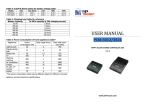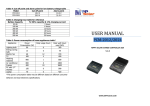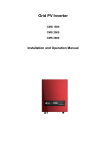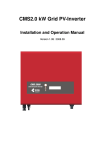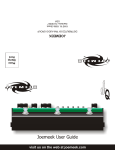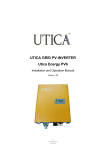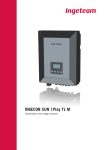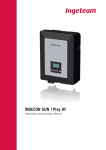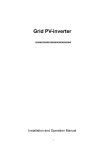Download Sunville® 6000 Grid PV-Inverter
Transcript
6000 Grid PV - Inverter 4.6KW OUTPUT Installation and Operation Manual Version 1.0 1 Contents Read this User Manual before you start ............................................................. 3 1. Safety Instructions............................................................................................. 4 2. Limited Warranty ............................................................................................... 5 3. Overview ............................................................................................................. 6 3.1. Introducing the Grid PV System ........................................................ 6 3.2. Introducing the Grid PV System ........................................................ 7 3.3. Front Panel LEDs .............................................................................. 8 4. Features.............................................................................................................. 9 5. Installtion .......................................................................................................... 10 5.1. Inside Inverter Package ....................................................... 10 5.2. Mounting your Inverter ......................................................... 10 5.3. Connecting the AC-Output Cable .................................................... 16 5.4. Connecting the PV-Panel ................................................................ 19 5.5. Connecting to the connection unit ................................................... 20 5.6. Installation checklist......................................................................... 20 6. Operation the Inverter ....................................................................... 22 6.1. Auto-power ...................................................................................... 22 6.2. Operating Modes ............................................................................. 22 6.3. Using the LCD Display .................................................................... 24 6.4. Maximum Power Point Tracking (MPPT) ........................................ 28 6.5. LCD Display Messages ................................................................... 29 7. Communication Interface ............................................................................... 32 7.1. RS232 .............................................................................................. 32 7.2. Optional Communications Interface ................................................ 32 8. Troubleshooting ............................................................................................... 33 9. Specifications ................................................................................................... 35 10. Compliance of Standards ............................................................................. 36 11. Load Graph and Efficiency Graph .............................................................. 37 Appendix I: VDE Certification ............................................................................ 38 2 Brightens your future Read this User Manual before you start Congratulations on purchasing 6000 Grid PV Inverter from MPP SOLAR (referred to in this manual as “PV-Inverter”, or simply the “device”). This PV-Inverter is a highly reliable product due to its innovative design and perfect quality control. The device is dedicated to high-demand, grid-linked PV systems. This manual contains important information regarding installation and safe operation of this unit. Be sure to read this manual carefully before using your PV-Inverter. If you encounter any difficulties during installation or operation, please refer to this manual before contacting your local dealer or representative. To obtain the latest manual and product information, please visit our web site: http://www.mppsolar.com 3 Brightens your future 1. Safety Instructions 1. Risk of Electric Shock: Alternating Current (AC) and Direct Current (DC) sources are terminated in this device. To prevent risk of electric shock during maintenance or installation please ensure that all AC and DC terminals are disconnected. 2. Handling your PV-Inverter: The PV-Inverter should only be handled by qualified service personnel. When the PV-panel is exposed to sunlight and connected to the device, it generates a DC voltage charging the DC link capacitors. After disconnecting the PV-Inverter from the power supply and PV-panel, electrical charge can still reside in the DC link capacitors. Qualified personnel should allow at least 60 minutes after disconnecting, before handling the device. 3. Public Utility only: The PV-Inverter is designed to feed AC power directly to the public utility power grid. Do not connect the AC-output of this device to any private AC equipment. 4. Beware of Hot Surfaces: Although designed to meet international safety standards, the PV- Inverter can become hot during operation. Do not touch the heat-sink or peripheral surfaces during or shortly after operation. 4 Brightens your future 2. Limited Warranty The 6000 PV-Inverter comes with a 5 year warranty. An optional extended warranty may be available by special request before delivery. This warranty covers all defects due to design, manufacturing and components. This warranty does not cover damages resulting from: Improper transportation and delivery Improper installation Unauthorized modification, testing or repairing Usage beyond that described in this manual Application beyond the scope of safety standards such as VDE, UL etc. Acts of nature, such as lightening, fire, storm etc. Repairs and/or replacement of parts or the device are made at the manufacturers discretion. Defective parts or malfunction discovered during installation should be presented in a written report for confirmation before applying for replacement or repair. The damage report must be issued within 5 working days after receiving the PV-Inverter. MPP SOLAR is not responsible for damages beyond the scope of this warranty. 5 Brightens your future 3. Overview 3.1. Introducing the Grid PV System The Grid PV System is mainly composed of 4 parts: the PV-panels, the PV-Inverter, the AC-Connection Unit (the connection Interface) and a connection to the Public Utility. When a PV-panel is exposed to sunlight and connected to an inverter, it generates DC power. The PV-Inverter converts DC to AC and feeds in to the Public Utility via the AC-Connection unit. Inverter Grid (Public Utility) + _ AC-Conne ction Unit DC-Input PV-Panel AC Output Feeding AC power to Public Utility only 6 Brightens your future 3.2. Introducing the Grid PV System (7) Front LCD Display Panel (1) Connection Panel (6) RS232 Connector (2) Heat-sink (5) Optional Communication Port and Cover (3) 3-pairs of DC inputs (4) AC Output 6000 Inverter (1) Connection Panel: The connection panel contains DC and AC terminals, and communication ports as detailed below. (2) Heat-sink: Part to dissipate heat produced by the inverter (3) 3 pairs of DC-input terminals: Each input pair consists of positive and negative terminals. Refer to Installation Section for set-up information. (4) AC-Output: Delivering AC to the Public Utility. (5) Optional Communication Slot and Cover: An optional port to extend the communication interface, for example connecting an RS485 card. The port is protected by a water-proof cover. (6) RS232 Port: Interface allows communication with computer with RS232 serial port. (7) LCD Display: Device to display inverter operation status. 7 Brightens your future 3.3. Front Panel LEDs There are 2 LED’s on Grid tied 6000, one is green and the other is red. Normally, only the green LED will turn on during operation. Their indicated status are explained as follows: Power on (green LED): It lights when Inverter is running. The only condition it will be dark is no power provided to inverter. In this case, Inverter is in shutdown mode. Fault (red LED): Once the LED lights, it means inverter is in “fault” or “failure” condition. To see the conditions, please refer to section 8: Function Key LCD (Liquid Crystal Display) Power-on LED Fault LED 8 Brightens your future 4. Features Very high conversion efficiency (>96%) 3 MPP (Maximum Power Point) trackers, independent or parallel operation IP65 compliant for outdoor application Embedded LCD, displaying status and system information Fanless design, quiet operation Stylish design Compact and unobtrusive High reliability Easy installation Maintenance free Standard RS232, optional RS485 and others Embedded ENS, complying with VDE 0126 Internal GFCI (Ground Fault Current Interrupter) 9 Brightens your future 5. Installation 5.1. Inside Grid tied 6000 Package The following items are included with your Inverter 6000 Package: (1) Inverter 6000 PV-Inverter (2) Installation and Operation Manual (3) 4 Mounting Screws and 4 Snap Bushings (4) 2 Safety-lock screws (5) 3-hole Rubber Bushing (6) Mounting Bracket 5.2. Mounting your Inverter 6000 Suggestions before mounting To obtain optimal results from your PV-Inverter, please consider the following guidelines before installing the device: Do not expose the PV-Inverter to direct sunlight. Direct sunlight increases the internal temperature that may reduce conversion efficiency. Check the ambient temperature of installation is within specified range -20 ~ +55C. The AC grid voltage is between 196 and 253VAC, 50/60Hz. Electric utility company has approved the grid connection. Qualified personnel are performing the installation. Adequate convection space surrounds the inverter. Inverter is being installed away from explosive vapors. 10 Brightens your future No flammable items are to be near the inverter. Inverter can be installed and operated at locations where the ambient temperature is up to 55 degrees Celsius. However the optimal condition is to install inverter where ambient temperature is between 0 to 40 degrees Celsius. 11 Brightens your future Mounting to the wall 1. Choose a dry place, out of direct sunlight with ambient temperature between 0 and 40°C. 2. Select a wall or solid, vertical surface which is strong enough to support the inverter. 3. The PV-Inverter requires adequate cooling space for heat dispersal. Reserve at least 20 cm above and below the inverter. Minimum space 20 cm Minimum space 20 cm 12 Brightens your future 4. Mark the positions of the 4 outer mounting holes onto the wall with the bracket as illustrated : Using the Outer Mounting Holes Upper Mounting Holes Lower Mounting Holes Mounting Bracket 13 Brightens your future 5. To install the device to a narrow upright, mark the 4 central holes at the back of the bracket. Using the Central Mounting Holes Upper Central Mounting Holes Lower Central Mounting Holes 6. Drill the 4 marked holes in the wall, and then drive in the 4 Snap Bushings. Now insert the screws, and tighten. Outer Mounting Holes Central Mounting Holes 14 Brightens your future 7. Mount the PV-Inverter onto the bracket as illustrated: Safety Lock Screw 8. Insert the Safety Lock screws to fix the PV-Inverter in place. 9. Install the device vertically to ensure the device is properly fixed to the bracket. LCD Display 15 Brightens your future 5.3. Connecting the AC-Output Cable Connect your PV-Inverter to the AC-Connection unit via the AC-output cable as following steps: AC-Output Connector AC-Output Cable (≥ 2.0mmØ) AC connection unit (consisting of breaker, fuse, terminals etc.) (1) Open the AC-output cover with a screw driver. (2) Draw out the AC Connector set from the Inverter. 16 Brightens your future (3) Unscrew the cable lock and prepare your AC cable. AC cable lock (4) Remove the rubber plug from inside the AC connector socket. Rubber Plug (no hole in it) (5) Insert the provided rubber bushing with three holes into the AC connector socket. 3-hole Rubber Bushing 17 Brightens your future (6) Now insert the three wires of the AC cable into the bushing holes. (7) Fix the brown wire to L (Line); the Light-blue wire to N (Neutral); and the Yellow-green wire to G (Ground). Note that all three wires should be at least 2.0mmØ All three wires should be firmly connected. L for Line N for Neutral G for Ground (8) After checking the 3 wires are fixed properly, push the AC-output connection set back in to the Connection Panel. Driver 4 screws back to fix the set 18 Brightens your future (9) Now screw on the Connector Locker to lock the bushing and cable together. 5.4. Connecting the PV-Panel (1) First make sure the maximum open circuit voltage Voc of each PV string is below 750VDC UNDER ANY CONDITION. (2) Always connect PV-Panel positive (+) terminal to PV-Inverter DC positive (+) terminal, and the PV-Panel negative (-) terminal to PV-Inverter DC negative (-) terminal. (3) Each set of PV-Inverter DC terminals takes a maximum DC input of 8.5A . As a result, 3 pairs of PV-Inverter DC terminals can take a combined input of up to 25.5A. 19 Brightens your future (4) To fully optimize the PV DC output set-up, use the following configuration guidelines: (a) For PV DC output less than 8.5A, use a single pair of PV-Inverter DC terminals. (b) For PV DC output between 8.5A and 17A, use two sets of inverter DC terminals. (c) For PV DC output between 17A and 25.5A, use 3 sets of inverter DC terminals. 5.5. Connecting to the connection unit The AC connection unit is an interface between your PV-Inverter and the Public Utility. It may consist of an electrical breaker, fuse and terminals for connection to both PV-Inverter and the Public Utility. This Connection unit must be designed by qualified technician to comply with local safety standards. AC-Output Port AC-Out Cable ( ≥ 2.0mmØ) AC connection unit (consisting of breaker, fuse, terminals etc.) 5.6. Installation checklist (1) High voltages exist when the PV-Panel is exposed to the sun. Exposed terminals of the PV-Panel are live, and can cause electric shock. Avoid making physical contact with live parts of the device. 20 Brightens your future (2) After the PV-Panels are connected to the PV-Inverter, the output voltage is greater than 100VDC and the AC grid is not connected to the inverter, the LCD displays “Model= XXXXXX”-> “Waiting”-> “No Utility”. The RED “fault LED” turns on. Initial Display before Connecting to the Public Utility Function Button No Utility Pac = 0.00 (3) Check the connection between your PV-Inverter and AC Connection System. And then check the connection between the Public Utility and AC Connection unit. Close the AC breaker or fuse in the unit. (4) Under normal operation, the LCD displays: Normal State Pac = XXXX.XW The PV-Inverter is feeding power to the grid, and the green LED displays. Before connecting PV-Panels to DC terminals, make sure the polarity of each connection is correct. An incorrect connection could permanently damage the device. (5) Congratulations, you have successfully installed your PV-Inverter! 21 Brightens your future 6. Operating the Inverter LCD Display Function Button No Utility Pac = 0.00 Power-on LED Fault LED 6.1. Auto-power The PV-Inverter starts up automatically once DC-power from the PV-Panel is sufficient. There are 3 modes of operation. 6.2. Operating Modes 1. Normal In this mode, the PV-Inverter automatically detects the system status and selects the best mode of operation. If the power from the PV-Panel is greater than 150VDC, the supply is converted to AC fed in to the grid. If the power is less than 100VDC, the PV-Inverter displays “Waiting”. During the wait state, the device uses minimal power from the PV-Panel to monitor the system status. During normal mode, the green LED is on. Normal State Pac = XXXX.XW 22 Brightens your future 2. Fault The PV-Inverter’s intelligent controller continuously monitors the system status. Unexpected conditions such as grid problems or internal failures are displayed on the LCD and the “Fault LED” turns on. Faults are indicated by the red “FAULT” LED. 3. Shutdown At the moment of reduced sunlight, the PV-Inverter automatically shuts down. No power is used from the grid, the LCD display and LEDs on the front panel do not work, and the function button is inactive. 4. Three Operating States: Standby, Waiting, Normal During normal operation, the PV-Inverter enters a ‘standby’ state at voltages below 100V. Between 100V and 150V the device enters the ‘waiting’ state and begins checking its own internal status. The ‘Normal’ state is entered when the voltage is above 150V. The following example shows the LCD when the PV-Panel input increases above 100V: The LCD first displays the model name Model= 6000 Pac = 0.0W When PV-Panel provides a voltage greater than 100V, the device enters the ‘Waiting’ state. Waiting Pac = 0.0W When PV-Panel provides a voltage greater than 150V, the PV-Inverter counts down from 20 to 0 whilst checking the internal status before entering the ‘Normal’ state. Checking 19 Pac = 0.0W Normal State Pac = XXXX.XW 23 Brightens your future Before connecting PV-Panels to DC terminals, make sure the polarity of each connection is correct. An incorrect connection could permanently damage the device. 6.3. Using the LCD Display Use the Function Button to customize the LCD display settings, or view further information about the internal status of your PV-Inverter. Press the Function Button to change the LCD display Pressing the Function Button during the ‘Normal’ state displays the grid voltage Normal State Pac = XXXX.XW Vac= xxx.xV Pac = XXXX.XW Pressing the Function Button twice reveals the grid frequency Frequency= XX.XHz Pac = XXXX.XW Pressing the Function Button three times displays the PV-Panel input voltage Vdc= ----/ ---- / ----V Pac = XXXX.XW Pressing the Function Button four times reveals the input current ldc=----/ ----/ ----A Pac = XXXX.XW Pressing the Function Button five times displays the output current to the grid 24 C-current = XX.XA Pac = XXXX.XW Brightens your future Press the Function Button six times displays the current energy output AC-current = XX.XA Pac = XXXX.XW Pressing the Function Button seven times displays the Model No. of the Inverter Energy = XXXKWh Pac = XXXX.XW Model= 6000 Pac = XXXX.XW Pressing Function Button nine times displays the firmware version Ver. 00. 01 Pac = XXXX.XW Pressing the Function Button a tenth time returns to the status display Normal State Pac = XXXX.XW Adjusting the LCD Contrast Rapidly press the Function Button during the ‘Normal’ state to display contrast settings Normal State Pac = XXXX.XW To adjust the contrast settings, press the Function Button again Contrast Pac = XXXX.XW Repeatedly press the Function Button until the contrast reaches the desired level Contrast Pac = XXXX.XW 25 Brightens your future After the highest level is reached, the contrast starts to decrease Contrast Pac = XXXX.XW A few seconds delay and the display automatically returns to its “Normal” display Contrast Pac = XXXX.XW Normal State Pac = XXXX.XW Changing the Language Repeat press the Function Button until “Set Language” shown on LCD Normal State Pac = XXXX.XW Press and hold the Function Button to change the language Set Language Pac = XXXX.XW Language: English Pac = XXXX.XW Press the Function Button cycles through the available languages After a brief period of inactivity, the display returns “Normal” Normal State Pac = XXXX.XW 26 Brightens your future Locking the display To lock the current display (for example, Frequency), press and hold the Function Button for about a second Frequency= XX.XHz Pac = XXXX.XW Locl Pac = XXXX.XW The screen displays “Lock” then returns to the previous screen Pressing the Function Button on the locked display changes to the next screen Frequency= XX.XHz Pac = XXXX.XW After a few seconds of inactivity the display returns to “Normal” AC-current= XX.XA Pac = XXXX.XW Normal State Pac = XXXX.XW Note: After 30 seconds of inactivity, the backlight switches off. Pressing the Function Button reactivates the backlight. Accuracy of the LCD Reading The reading on the LCD is just for reference. The readings during normal operation are accurate to +/- 2%. Over all modes of operation please allow +/- 5%. The LCD Visibility and Ambient Temperature Temperature extremes can influence the visibility of an LCD display. Visibility returns to normal within tolerable temperatures (see Installation chapter). 27 Brightens your future 6.4. Maximum Power Point Tracking (MPPT) Due to its advanced design, your PV-Inverter can track the maximum power from any PV-Panel under any condition. When the output power display is stable, your PV-Inverter is converting the maximum power available. When the power reading fluctuates, the device is tracking power changes due to varying levels of sunlight. Individual PV-Panel Output Graph If the output of the PV-Panel is low, the AC power may drift slowly. It is normal because your PV-Inverter continuously tracks the maximum DC-power and the display reflects the varying power. 28 Brightens your future 6.5. LCD Display Messages Operating conditions Message in English Description Normal working status Power off No display PV inverter is totally shutdown, VPV ≤ 80V Standby Standby 80V< Input voltage ≤ 100V Initialization & waiting Waiting Input voltage range 100~150V during start-up. After PV voltage is higher than 100V, inverter is waiting for feeding to grid Check grid Checking Feeding grid, MPPT Normal State FLASH Instantaneous Output power Accumulated energy information When PV voltage > 150V, inverter is checking feeding conditions Inverter is feeding power FLASH FLASH firmware Monitoring parameters Pac=xxxxW The real time output power in xxxx W Energy=xxxxxxkWh Total energy to has been fed to grid since inverter was installed Grid voltage Vac=xxx.xV Grid voltage in xxx.x VAC Grid frequency Frequency=xx.xHz Grid frequency in xx.x Hz Feeding current AC Current=xx.xA Feeding current amount in xx.x A PV array voltage PV array current Vdc=xxx/xxx/xxxV Input voltage from PV array, xxx.x VDC Idc=xxx/xxx/xxxA Input current from PV array, xxx.x A System fault Isolation failure Isolation fault Earth fault of the PV-panels or failure of surge voltage protection GFCI active Ground I fault Grid failure Grid fault Leakage current on ground conductor is too high Grid measured data is beyond the specification (voltage & frequency) LCD Display Message Continued Abnormal Grid Impedance Impedance fault 29 1. Grid impedance higher than the permissible value Brightens your future 2. Grid impedance change (∆Z) is higher than limit No utility No Utility Input voltage too high PV over voltage Utility is not available Consistent failure Consistent fault Temperature too high Over temperature Output relay failure Relay Failure The relay between inverter and grid is not functional Output DC Injection too high DC INJ High Output DC injection too high EEPROM problem EEPROM Failure EEPROM inside has data access problem Communication between microprocessors problem SCI Failure The communication between MCU inside is abnormal DC bus voltage is too high High DC Bus The DC BUS inside is higher than expected DC bus voltage is too low Low DC Bus The DC BUS inside is lower than expected 2.5V reference voltage inside problem Ref 2.5V Fault Output DC sensor abnormal DC Sensor Fault GFCI detection problem GFCI Failure Input voltage higher than the 750V Inverter fault The readings of 2 microprocessors are not consistent. It could be caused by CPU and/or other circuit do not function well The internal temperature is higher than normal value The 2.5V reference inside are abnormal The DC output sensor is abnormal The GFCI detection circuit is abnormal LCD Display Message Continued Inverter fault Model display Model = xkW Inverter model, xkW inverter LCD contrast setting Set Contrast Setting the contrast of inverter LCD display lock Lock Hold the present display message 30 Brightens your future Waiting for reconnect Reconnect in xxx sec The time for reconnect to grid to grid Firmware version Ver xx.xx Setting Language Set Language F/W version information 31 Set up of the display language Brightens your future 7. Communication Interface 7.1. RS232 Your PV-Inverter is equipped with a versatile communications interface. Use Inverter 6000 “EZ Control” to monitor status of multiple inverters. Firmware upgrades are also available via this interface. Inverter 6000 is integrated with a DB9 socket for the RS232 interface. Remove the DB9 socket cover before use. Pin assignment of this DB9 socket is stated as below: Pin 1 2 3 4 5 6 7 8 9 le Signal Assignment N.C. TxD RxD N.C. Common N.C. N.C. N.C. N.C. 7.2. Optional Communications Interface Your PV-Inverter has an expansion slot for an optional communications interface. Add a Inverter RS485 card or compliant card to extend the communication functions of inverter. RS232 port & cover Communication Slot 32 Brightens your future 8. Troubleshooting Your PV-Inverter requires very little maintenance. When unexpected situation occurs, please refer to the following table should further assistance be required before calling your local dealer. The following table lists common fault messages that display when the fault LED is lit, and their solutions. Troubleshooting your PV-Inverter Fault Diagnosis and Solution Message (1) Isolation Fault (2) (1) (2) System Fault Ground I Fault (3) (4) Grid Fault Impedance Fault (1) (2) (3) (1) (2) (3) (4) No Utility (5) (1) (2) (3) Check the impedance between PV (+) & PV (-) and ground. The impedance should be larger than 8Mohm. If the check fails, or the impedance is below 8Mohm, please call service. This is caused by too high ground current. Unplug the PV generator from the DC-input, check the AC peripheral system. After the cause is cleared, plug PV in again and check the status of Inverter. If above actions cannot clear Ground I fault, please call service. Wait for 1 minute for Grid to come back to normal. Make sure Grid voltage and Frequency meet the specifications. If not, please call service. Grid impedance higher than the permissible value. Observe the faulty condition for 1 minute. If it does not restore to normal, check the wires between inverter and grid. Change larger wires if necessary. Adjust impedance parameter using the Inverter EZ control. If above actions are vain, please call service. Grid is not connected. Check grid connection, such as wire and connector. Check Grid usability 33 Brightens your future Troubleshooting your PV-Inverter Fault Diagnosis and Solution Message (1) PV Over Voltage Consistent Fault SCI Failure (2) (1) (2) (1) Over Temperature Inverter Failure Relay Failure (2) (3) (4) (1) (2) (1) DC INJ High (2) (3) (1) EEPROM Failure (2) (1) High DC Bus (2) (3) Check open PV voltage, see if it is too close to or over 750VDC. If PV voltage is less than 750Vdc, and the problem still occurs, please call service. Disconnect PV(+) and PV(-) from the input, start the unit again. If it does not work, please call service. The internal temperature is higher than specified normal value. Reduce the ambient temperature by some appropriate and effective way. Or move Inverter to a cooler location. If it does not work, please call service. Disconnect PV(+) and PV(-) from the input, start the unit again. If it does not work, please call service. Grid DC current higher than the permissible value. Observe the faulty condition for 1 minute. If it does not restore to normal operation, please call service. Disconnect PV(+) and PV(-) from the input, start the unit again. If it does not restore to normal operation, please call service. Disconnect PV(+) and PV(-) from the input, start the unit again. Check if L-LINE and N-Neutral are mistakenly connected. If so, please call service. Low DC Bus Ref 2.5V Fault (1) Disconnect PV(+) and PV(-) from the input, start DC Sensor the unit again. Fault (1) If it does not work, please call service. GFCI Failure 34 Brightens your future 9. Specifications Grid tied 6000 Model Nominal output power Max. power 4600W 5100W Input Nominal DC voltage Maximum PV open voltage MPPT range Working range Max. input current 600 VDC 750 VDC 125V to 700Vdc 100V to 750Vdc 8.5ADC Output Operational voltage Operational frequency Current distortion Power factor Conversion efficiency(max) European efficiency 196~253Vac 50/60Hz, auto selection <3% >0.99 >96% >94.5% Environment Protection degree Operational temperature range Humidity Heat Dispersal Power consumption Acoustic noise level IP 65 -20 to 55°C 0 to 95%, non-condensing Convection ~9W <30dBA Communication & Features LCD Comm. Interface F/W upgrade 2-Line, 16 characters. Information changeable by Function key on the panel RS485 and others optional Yes, via RS232 Mechanical W x D x H (mm) Weight (kg) 430 x 530 x 130 27 *The product’s specifications are subject to change without notice. 35 Brightens your future 10. Compliance of Standards EMC: DIN EN 50081, part 1 (EMV-interference emission) (EN 55014, EN 60555 part 2, EN 55011 group 1, class B) DIN EN 50082, part 1 (EMV-interference immunity) Grid Interference: DIN EN 61000-3-2 Grid Monitoring: Independent disconnection device (MSD, Mains monitoring with allocated Switching Devices) according to VDEW; EN DIN VDE 0126 (04.99) Low Voltage Regulation: DIN EN 50178 (4.98) (VDE 0160) (will be IEC62103) DIN EN 60146 part 1-1 (3.94) (VDE 0558 part 11) 36 11. Load Graph and Efficiency Graph The relationship between PV input voltage (V PV) and input power (Ppv) is shown in the following example. Once PV input voltage is less than 447V, the relation of VPV and power is: Ppv(W) = 8.5 x Vpv Example: VPV is 400VDC, the maximum power could take by inverter in one string is 3400W. Load Graph Ppv(W)=8.5 x Vpv The typical efficiency chart related to VDC and PAC is shown below. Note: Results may vary due to test equipment tolerances and product differences. Typical Efficiency Graph for Grid tied 6000 37





































